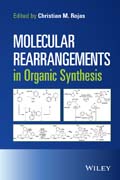
Designed for practitioners of organic synthesis, this book helps chemists understand and take advantage of rearrangement reactions to enhance the synthesis of useful chemical compounds. Provides ready access to the genesis, mechanisms, and synthetic utility of rearrangement reactions Emphasizes strategic synthetic planning and implementation Covers 20 different rearrangement reactions Includes applications for synthesizing compounds useful as natural products, medicinal compounds, functional materials, and physical organic chemistry INDICE: 1,2–MigrationsChapter 1 Pinacol and Semi–Pinacol Rearrangements in Total Synthesis1. Introduction2. Pinacol Reaction3. Semipinacol Rearrangement4. Conclusion5. ReferencesChapter 2 Baeyer–Villiger (BV) Oxidation/Rearrangement in Organic Synthesis1. Introduction2. Mechanism3. Synthetic applications4. Summary and outlook5. ReferencesChapter 3 The Wolff rearrangement: tactics, strategies and recent applications in organic synthesis1. Introduction2. Tactics and strategies via the Wolff rearrangement3. Mechanistic features and selectivity issues of the Wolff rearrangement4. Preparation of diazocarbonyl compounds5. Recentsynthetic applications of the Wolff rearrangement6. Conclusion and outlookChapter 4 Alkyl and acyl azide rearrangements1. Introduction2. Alkyl Azide Rearrangements3. Acyl Azide Rearrangements4. Hofmann Rearrangement5. Lossen Rearrangement6. ConclusionChapter 5 Beckmann Rearrangements and Fragmentations in Organic Synthesis1. Introduction2. Strategic Planning: A Historical Perspective3. Recent Applications Toward the Synthesis of Natural Products4. Access to Diverse Scaffolds via the Beckmann Reaction5. Formation of Heterocyclic Scaffolds6. Synthesis of Functional Groups7. Summary and OutlookReferencesChapter 6 Brook Rearrangement1. Introduction2. Mechanism3. Methods for Generation of Silyl Alkoxides4. Synthetic Reactions Using Brook Rearrangements in the Reactions of Acylsilanes with Nucleophiles5. Synthetic Reactions Using Brook Rearrangements Triggered by Deprotonation of Silyl Alcohols6. Synthetic Reactions Using Brook Rearrangements Triggered by Addition of Silylmetallic Reagents7. Synthetic Reactions Using Brook Rearrangements in Silyl Alkoxides Generated via Regioselective –Ring–Opening of Epoxysilanes by a Nucleophile8. Synthetic Reactions Using Brook Rearrangements in Silyl Alkoxides Generated by a Base–Induced Ring–Opening of Epoxysilanes9. Conclusion1,2–Migrations via Three–Membered RingsChapter 7 The Quasi–Favorskii Rearrangement1. Introduction2. Retrons of the Quasi–Favorskii Rearrangement3. Mechanistic Considerations in the Quasi–Favorskii Rearrangement4. The Preparation of Substrates for the Quasi–Favorskii Rearrangement5. Applications of the Quasi–Favorskii Rearrangement in Synthesis6. Conclusions and ProspectsChapter 8 The Ramberg–Bäcklund Reaction1. Introduction2. Methods to Synthesize sulfones as RBR Precursors3. Variations of the RBR4. Mechanistic Evaluation of the RBR5. Strategic Considerations Relevant to the use of the RBR in Synethsis6. Utility, Scope and Limiations of the RBR7. Recent Applications of the RBR in the Synthesis of Complex Target Structures8. Concluding remarksChapter 9 Applications of Di–p–Methane and Related Rearrangement Reactions in Chemical Synthesis1. Introduction The Basic Process and its Variants2. Mechanistic Features and Competing Reactions3. Structural Requirements of Substrates and Matters of Regio– and Stereo–chemistry4. Synthetic Routes to Substrates and Applications in Synthesis5. Outlook6. References and Footnotes1,3–TranspositionsChapter 10 Payne Rearrangement1. Payne rearrangement2. Construction of requiste starting materials for Payne rearrangement3. Utilization of the Payne rearrangement for the preparation of fluoride4. Conclusion5. ReferencesChapter 11 Vinylcyclopropane–Cyclopentene Rearrangement1. Introduction2. Thermal vinylcyclopropane–cyclopentene rearrangement3. Acid–mediated vinylcyclopropane–cyclopentene rearrangement4. Mechanistic5. Heteroatom–containing analogues of vinylcyclopropane–cyclopentene rearrangement6. Applications in Synthesis7. Photochemical vinylcyclopropane–cyclopentene rearrangement8. Metal–catalyzed vinylcyclopropane–cyclopentene rearrangement9. Heteroatom–variants of the metal–catalyzed vinylcyclopropane– cyclopentene rearrangement10. Summary and OutlookReferencesChapter 12 Ferrier Carbocyclization ReactionIntroduction1. General Discussion and Mechanistic Features2. Synthetic Strategies Based on the Ferrier Carbocyclization Reaction3. Methodologies for Assembling Ferrier Carbocyclization Substrates4. Applications of the Ferrier Carbocyclization Reaction in Natural Product SynthesisConclusionReferences[3,3]– and [2,3]–Sigmatropic RearrangementsChapter 13 The Claisen Rearrangement1. Introduction2. Strategic planning for the Claisen rearrangement reaction3. Mechanistic features of the Claisen rearrangement reaction4. Methodologies for synthesis of Claisen rearrangement substrates5. Application of the Claisen rearrangement reaction in target–oriented Synthesis6. ConclusionChapter 14 [3,3]–Sigmatropic Rearrangements with Heteroatom–Heteroatom Bonds1. Introduction2. [3,3]–Sigmatropic Rearrangements of N O Bonds3. [3,3]–Sigmatropic Rearrangements of N N Bonds4. [3,3]–Rearrangements of N N bond Fragments that Eliminate N25. Summary6. ReferencesChapter 15 [2,3]–Rearrangements of Ammonium ZwitterionsIntroduction1. [2,3]–Meisenheimer Rearrangement of Amine N–oxides2. [2,3]–Stevens Rearrangement of Ammonium YlidesConclusion and OutlookReferencesChapter 16 Oxonium Ylide Rearrangements in Synthesis1. Introduction2. Applications in Synthesis Oxonium Ylide [2,3]–Sigmatropic Rearrangements3. Applications in Synthesis Oxonium Ylide [1,2]–Stevens RearrangementsChapter 17 The [2,3]–Wittig Rearrangement1. Introduction2. [2,3]–Wittig rearrangement of allyl–propargyl ethers3. Factors determining [2,3]–Wittig versus [1,2]–Wittig rearrangement4. [2,3]–Wittig–Still rearrangement5. Asymmetric [2,3]–Wittig rearrangement6. Aza–[2,3]–Wittig rearrangement7. Other Wittig rearrangements and miscellaneousConclusionReferencesChapter 18 The Mislow Evans Rearrangement1. IntroductionPart I. Mechanistic aspects and the [2,3] nature of the rearrangement2. Configurational lability of allylic sulfoxides3. Deuterium labeling to track [2,3] pathway4. Transition state features5. Equilibrium between sulfoxide and sulfenate6. Chirality transferPart II. Synthetic considerations and applications7. Alkene stereoselectivity8. Diastereoface selectivity in the rearrangement9. Epimerizations via Mislow Evans rearrangement sequences10. Vinyl anion synthons accessible via Mislow Evans rearrangement11. Sequential processes incorporating the Mislow Evans rearrangement12.Heteroatom [2,3]–rearrangement variants13. [2,3] Rearrangements of propargyl and allenyl sulfenates and sulfoxides14. ConclusionIpso RearrangementsChapter 19 Smiles Rearrangements1. Introduction2. Scope and mechanistic features3. Application of Smiles rearrangements4. ConclusionChapter 20 Pummerer–type Reactions as Powerful Tools in Organic Synthesis1. Classical Pummerer reaction2. Vinylogous Pummerer reaction3. Interrupted and additive Pummerer reactions4. Connective Pummerer reactions5. Pummerer rearrangement in multiple–reaction processes6. Other Pummerer rearrangements7. Summary and Outlook . .
- ISBN: 978-1-118-34796-6
- Editorial: Wiley–Blackwell
- Encuadernacion: Cartoné
- Páginas: 528
- Fecha Publicación: 18/11/2015
- Nº Volúmenes: 1
- Idioma: Inglés
